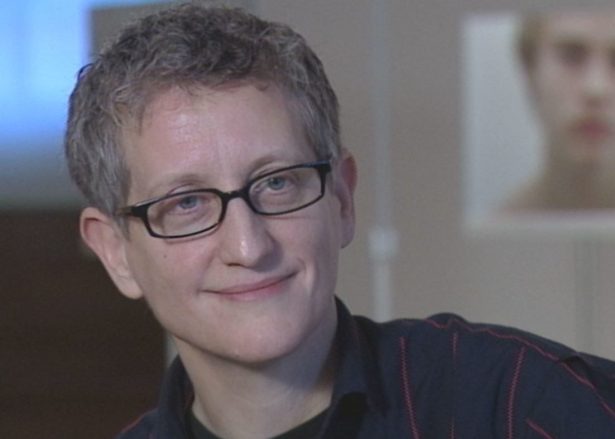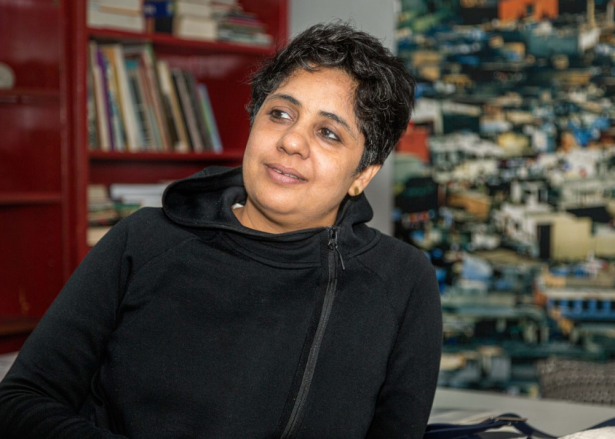This post comes from the Artists and Climate Change Blog
Fall is officially here in New York City. For many on the East coast, and especially in the Carolinas, the season has been devastating. Evacuations are still taking place in parts of South Carolina a week after Hurricane Florence due to historic flooding. Scientific evidence predicts that climate change will cause storms like Florence to grow larger and more frequent in the years to come. Climate change communication efforts are therefore more important than ever, and the artists and writers I profile here are taking part in those efforts.
This month I have for you an exclusive interview with novelist Cai Emmons. Her novel Weather Woman hits shelves in October. It follows the story of 30-year-old Bronwyn, who drops out of her doctoral program and takes a job as a TV meteorologist. After being dumped by her boyfriend, she discovers that she has the ability to affect the weather. Weather Woman is a beautifully written and deeply engaging novel that had me hooked from page one.
Your novel has a fantastical element in that the protagonist, Bronwyn Artair, can directly affect the weather. But the novel is also rooted in reality with its references to climate-related phenomena like wild fires, extreme weather patterns, and the effects of Siberian methane field emissions on the atmosphere. What inspired such a rich and interesting story?
A novel idea crystallizes for me when two persistent thoughts dovetail. Since I was a small child in New England, I have always been fascinated by weather, extreme weather in particular. On many occasions I have wanted fervently to change the weather, to favor activities like swimming or trick-or-treating. As an adult, when I awoke to a downpour on my wedding day I desperately wanted to stop it. This idea connected with one of my favorite books as a child, Oliver Butterworth’s The Trouble with Jenny’s Ear, in which a young girl realizes she can read people’s thoughts. At some point along the way a what if sprang up in my mind: What if a person really could change the weather? That premise led to a consideration of what such a person could do in terms of changing the climate.
Are you concerned about climate issues beyond what you write about in your fiction?
Perhaps because of having been attuned to the weather, I have been obsessed with climate change for years. To my mind the warming planet presents an enormous threat to human survival, particularly because it gives rise to a host of other life-threatening circumstances such as drought, fires, floods, famine, disease, mass migration, war, etc. It is incomprehensible to me that this threat has not given rise to hysteria and a massive remedial effort in response. I am interested in the work of sociologist Kari Norgaard who has attempted to understand the general malaise regarding climate change, especially among people who acknowledge both that it is happening and that it is human-caused.
I, too, feel largely helpless in the face of the changes I see. The fires raging across the planet this summer are on my mind now. I support 350.org, I go to climate rallies, I try to ride my bike as often as possible, but I often feel that I come up short in terms of having significant impact. I try to guard against despair, but I confess to frequently feeling very bleak about the subject when I awake in the wee hours.
Weather Woman brushes up against how climate change is addressed (or not) in the press, both in the character of tabloid journalist Matt and Bronwyn’s own experiences. The question of how the American press in particular reports on climate change haunted me as I read. What are your thoughts on the subject?
I have read some excellent coverage of the climate crisis in The New York Times and The New Yorker, along with various other publications (The Washington Post, National Geographic, etc.). Some of these articles have been very informative, others have been deeply alarming. But I am always acutely aware of the limitations of journalism in a culture that is so heavily polarized as ours now is. I may be drawn to every article I see about the unfolding climate disaster, but are these articles reaching people who know nothing about how dire the situation is, or those who actively oppose the idea that a problem exists. I doubt it.
I ask myself when it might be appropriate for journalists and scientists who are well-informed about what is happening to become advocates for action. I have watched my friend, Jason Box, glaciologist and climate scientist, struggle with this question as he tiptoes in the direction of advocacy.
In some ways, Weather Woman is about personal responsibility. Bronwyn has the supernatural power to affect the weather, but looked at a different way, so do we all. Climate change has been brought about because of anthropogenic activity, and we’ve only begun to see the effects of that activity. The presence of this theme suggests that this is something you’ve thought a lot about. Would you discuss your artistic process for coming up with this theme and how you teased it out?
I think a lot about what the path forward is in addressing climate change. I see the U.S. as deeply crippled by the cultural attitude that prizes individual rights over the needs of the community. This prevailing ethos means that we tend to view solutions to climate change in individual terms. I live in a small liberal Oregon city whose residents (many of them) pride themselves on being good custodians of the Earth. People here recycle, drive hybrid cars, ride bikes, eschew meat. This is all laudable, and it makes people feel good about themselves, but the impact is minor and does not address the problem head-on. We need large-scale collective action to change laws, regulate emissions, ban human practices that are deleterious to the environment. Only when we act together will our actions be consequential.
At some point in the writing of the novel I realized I did not want Bronwyn to be a singular heroine of the climate crisis, letting the rest of us off the hook. This is what she comes to understand near the end of the novel. Even with her considerable power she is not capable of saving the planet alone. This is what the Arctic fox tries to tell her when he says:Â Where are your people?Â
Throughout the book Bronwyn has to deal with skeptics. How do you deal with skeptics?Â
Skeptics, OMG! This was actually a fun element for me to work with as a novelist, particularly in terms of who was going to believe in Bronwyn’s power. She is aware of moving in a world in which she is unlikely to be believed. A few characters like Nicole and Earl believe in her power immediately, but others—most notably her mentor, Diane—are hard to convince, even after they’ve seen her at work. I wanted to feature diverse reactions to make readers wonder how they would be likely to react.
I mostly feel that it is a waste of time to try to convince people to believe in something they are dead set against, whether it is a superpower or climate change. My brother-in-law does not believe in man-caused climate change, but to engage with him about this is to bring on a shouting match. People rarely change when they feel bullied or threatened or humiliated (I don’t think I bully or threaten or humiliate, but I think even a rational conversation can bring up those feelings). If people are going to change it is usually a process that happens over time, in private, when they have been exposed to new information and feel free to consider things differently without being judged.
What do you think fiction can show or teach us about climate change that, say, scientific reports can not?
I think novels can be stealthy in a way that it is hard for journalistic or scientific work to be. The questions a novel raises piggyback on the lives of characters with problems and emotions readers recognize and participate in. If we, as readers, have stepped into the shoes of a character we can often embrace experiences and feelings, and even thoughts and opinions, that are antithetical to our own. I think most of us have had the experience of discovering a friend thinks differently about something than we do. Usually, rather than dropping the friend, we reevaluate our own position. Novels can, at their best, have the same impact.
Weather Woman hits shelves in October via Red Hen Press.
This article is part of the Climate Art Interviews series. It was originally published in Amy Brady’s “Burning Worlds†newsletter. Subscribe to get Amy’s newsletter delivered straight to your inbox.
___________________________
Amy Brady is the Deputy Publisher of Guernica magazine and Senior Editor of the Chicago Review of Books. Her writing about art, culture, and climate has appeared in the Village Voice, the Los Angeles Times, Pacific Standard, the New Republic, and other places. She is also the editor of the monthly newsletter “Burning Worlds,†which explores how artists and writers are thinking about climate change. She holds a PHD in English and is the recipient of a CLIR/Mellon Library of Congress Fellowship. Read more of her work at AmyBradyWrites.comand follow her on Twitter at @ingredient_x.Â
Artists and Climate Change is a blog that tracks artistic responses from all disciplines to the problem of climate change. It is both a study about what is being done, and a resource for anyone interested in the subject. Art has the power to reframe the conversation about our environmental crisis so it is inclusive, constructive, and conducive to action. Art can, and should, shape our values and behavior so we are better equipped to face the formidable challenge in front of us.









































